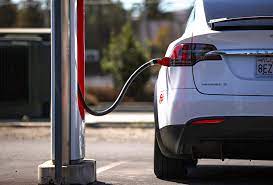The Inflation Reduction Act that Congress passed earlier this year was hailed by the wind, solar, and EV manufacturing industries and environmentalists as the key to the energy transition, providing billions in funding for low-carbon electricity production and, of course, EVs.
Because of the ambitious EV plans of the administration—and of several state governments—building a charging network across the country was a crucial part of the IRA. But it could turn out to be one of those things that are easier said than done.
A recent study by the U.S. division of British National Grid—in partnership with a couple of transition nonprofits and two EV-focused tech firms—found something that electricity-savvy people have been saying for years: the EV revolution will lead to a massive uptick in electricity demand.
It’s not just the increase in demand, either. It’s a specific increase in demand at future charging points for EVs and trucks that would make it necessary to increase the supply of electricity at these points. And this increase will need to be quite substantial.
According to the study, which focused on New York and Massachusetts to gather its data and make its predictions, current traffic patterns in the two states suggest that many sites—such as truck stops, for example—would need to be equipped with 20 fast EV chargers or more in a best-case scenario where the adoption of EVs and electric trucks is as massive as hoped.
And this, in turn, means that these sites would require the same amount of electricity as a small town, the study’s authors note. Now, let’s extrapolate from the New York and Massachusetts data: mass adoption of EVs and electric trucks would likely lead to the emergence of a lot of “small towns” across the United States. And some of the country’s utilities are already experiencing trouble securing a reliable supply of electricity.
This summer, blackouts were a threat in several parts of the United States, and not just California, which has had these problems before, None other than MISO, the Midcontinent Independent System Operator, which oversees the Midwest’s grid, said there is a risk of blackouts because the supply of electricity is falling behind demand. And the reasons for this discrepancy are far from gone
At the time, the risk was explained by greater exports of coal and gas to Europe amid the continent’s supply crunch in the wake of the Russian sanctions but also with the retirement of coal and gas-powered plants.
“Conventional power plants are being retired and there are significant supply chain and technology challenges to replace this base load power. Planned renewable energy and storage projects are being delayed and costs are rising due to these challenges,” one energy cooperative wrote in June.
A Bloomberg author, Tom Randall, dismissed the problem of electricity supply in a commentary piece on the National Grid study, saying that even if all carmakers stopped making ICE cars by the early 2030s, this would increase global electricity consumption by “no more than” 15 percent by 2040, per BloombergNEF data. That 15 percent might seem like nothing much to some, but it is, in fact, 15 percent of a huge figure. For example, in 2019, the last year before the pandemic, the world consumed 22,848 TWh of electricity, which was up 1.7 percent from 2018, according to IEA figures.
The two pandemic years featured a slump in this consumption, but since 2021, demand for electricity has rebounded, and it has rebounded strongly. Over the first half of the year, according to transition nonprofit Ember, global electricity consumption reached 13,393 TWh, up from 13,004 TWh
So far, so good, because, Ember added, the whole increase in demand for electricity was met by additional wind and solar power capacity. An argument echoed by Bloomberg’s Randall, a buildup in wind and solar has been promoted as the solution to any potential shortfalls in electricity supply.
In fact, Randall made a point of not only brushing aside any concerns about shortfalls, but said that “In the age of cheap wind and solar power, that’s [the 15-percent consumption increase] not a lot.”
The fact is that the age of cheap wind and solar power is on its way out, and this is what could really change the economics of all those optimistic clean energy and transport electrification plans
In the EU, some are already sounding the alarm already. Solar power equipment manufacturers are calling on governments for more financial help because their costs are soaring and costs are soaring because electricity and fossil fuel costs are soaring, and the production of solar power equipment is often an energy-intensive process, ironically dependent on fossil fuels.
The U.S. appears to have been more generous with its support, but no amount of government subsidies can solve the problem of the looming supply shortage in key materials such as copper and lithium.
These shortages are already beginning to push up the costs of EVs as well as wind and solar installations. It might be wise not to try and overlook this aspect of transition efforts when making plans for adding the equivalent of dozens of new small towns to the U.S, or any other, grid.

 Iran Energy News Oil, Gas, Petrochemical and Energy Field Specialized Channel
Iran Energy News Oil, Gas, Petrochemical and Energy Field Specialized Channel



